- Chrysler 300 letter series
-
This article is about the Chrysler 300 cars from the 1950s and 1960s. For the cars which succeeded these in the 1960s and 1970s, see Chrysler 300 non-letter series. For the modern car built under the same name, see Chrysler 300.
Chrysler 300 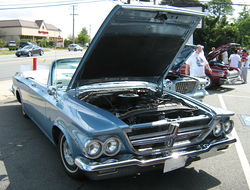
1964 Chrysler 300 K convertibleManufacturer Chrysler Corporation Production 1955-1965
1970Layout FR layout The Chrysler 300 "letter series" were high-performance luxury cars built in very limited numbers by the Chrysler Corporation in the U.S. from 1955-1965. Each year's model used a new letter of the alphabet as a suffix (skipping "i"), reaching 300L by 1965, after which the model was dropped.
The 300 "letter series" cars were among the vehicles that focused on performance built by domestic U.S. manufacturers after World War II, and thus can be considered one of the muscle car's ancestors, though much more expensive and exclusive.
Chrysler has recently started using these designations again for sporting high performance-luxury sedans, using 300M from 1999, and continuing the 300 series with a new V8-powered 300C, the top model of a relaunched Chrysler 300 line, a new rear-wheel drive car launched in 2004 for the 2005 model year. Unlike the first series, the second does not have 300 hp (220 kW) engines, except for Chrysler's current top-line 300C models.
Contents
1955 C-300
C-300 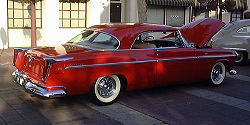
Production 1955 Body style 2-door coupe Engine 331 cu in (5.4 L) 300 hp (220 kW) V8 This first of the letter series cars didn't actually bear a letter; it can retroactively be considered the '300A'. The 'C-' designation was applied to all Chrysler models, however for marketing purposes the numerical series skipped more than 225 numbers forward in sequence in order to further reinforce the 300's bhp rating. The 300 originally stood for the 300 hp (220 kW) engine. The C-300 was really a racecar aimed at the NASCAR circuits that was sold for the road for homologation purposes, with Chrysler's most powerful engine, the 331 cu in (5.4 L) FirePower "Hemi" V8, fitted with twin 4-barrel carburetors, a race-profiled camshaft setup, solid valve lifters, stiffer suspension and a performance exhaust system. By 1956 this would be the first American production car to top 355 hp (265 kW), and the letter series was for many years the most powerful car produced in the United States.
The car's "Forward Look" styling can be attributed as much to the Chrysler parts bin as designer Virgil Exner. The front clip, including the grille, was taken from the Imperial of the same year, but the rest of the car did not look like an Imperial. The midsection was from a New Yorker hardtop, with a Windsor rear quarter. Exner also included base-model Chrysler bumpers and removed many exterior elements such as back-up lights, hood ornament, side trim, and exterior mirrors. There were few options available including selection of three exterior colors (red, white and black) and only one color of tan leather interior. Power windows and power seat were available but air conditioning was not available in 1955. At least one known 1955 C-300 had A/C as a special order for a Chrysler executive.
Measured at 127.58 mph (205.32 km/h) in the Flying Mile, and doing well in NASCAR, the C-300 aroused a lot of interest that was not reflected in its modest sales figure of 1,725 built.
1956 300B
300B 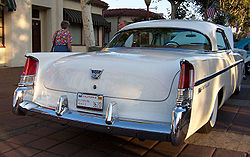
Production 1956 Body style 2-door coupe Engine 354 cu in (5.8 L) 340 hp (250 kW) V8
354 cu in (5.8 L) 355 hp (265 kW) V8The 1956 300B was fairly similar externally, distinguished by a new tailfin treatment, but with larger engines, two models of 354 cu in (5.8 L) Hemi V8 with either 340 or 355 hp (254 or 265 kW). Only 1,102 were sold. Performance was a little better than the previous year's, being measured at almost 140 mph (225 km/h). A 6.17 ratio rear end was also added to the options.
With the optional 355 hp 354 cu.in engine, the 300B became the first American car to produce 1 horsepower per cubic inch, besting Chevrolet with their fuel-injected 283 cu in (4.6 L) by one year.
1957 300C
300C 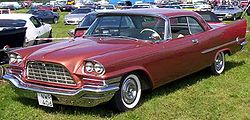
Production 1957 Body style 2-door coupe
2-door convertibleEngine 392 cu in (6.4 L) 375 hp (280 kW) V8 Wheelbase 126.0 in (3,200 mm) Length 219.2 in (5,568 mm) Width 78.8 in (2,002 mm) The 1957 300C is generally considered the classic year of the 300 "letter series". New styling was brought in, with a yawning wide front grille and fins; the Hemi engine was upgraded to 392 cu in (6.4 L) with 375 hp (280 kW), or as a very limited edition 390 hp (290 kW) version (18 built). A convertible model was available for the first time. The car had a number of red, white, and blue '300C' medallions on the sides, hood, trunk and interior. 1,767 coupes and 484 convertibles were built.
1958 300D
300D Production 1958 Body style 2-door coupe
2-door convertibleEngine 392 cu in (6.4 L) 380 hp (280 kW) V8 Wheelbase 126.0 in (3,200 mm) Length 219.2 in (5,568 mm) Width 78.8 in (2,002 mm) The 1958 model year was to be the last use of the old FirePower Hemi in the 300. The engine was still 392 cu in (6.4 L), but tuned to 380 hp (280 kW) as standard. Thirty-five cars were built with fuel injection and delivered 390 hp (290 kW), but the fuel injection system was troublesome and most cars soon had it replaced with the standard twin-quad carburetor setup. A 300D was driven to 156.387 mph (251.680 km/h) at the Bonneville Salt Flats that year, but only 618 hardtops and 191 convertibles were produced, in part due to a recession in the economy.
1959 300E
300E Production 1959 Body style 2-door coupe
2-door convertibleEngine 413 cu in (6.8 L) V8 1959 saw the Hemi engines replaced by Chrysler's new Golden Lion wedge-head V8 at 413 cu in (6.8 L) displacement. Power output remained about the same at 380 hp (280 kW). The loss of the Hemi and the late-1950s recession meant sales of 522 coupes and 125 convertibles.
1960 300F
300F 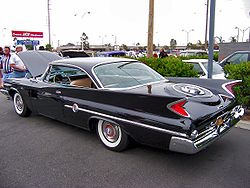
Production 1960 Body style 2-door coupe
2-door convertibleEngine 413 cu in (6.8 L) V8 Transmission 3-speed automatic or (for racing/very special order) 4-speed manual The 1960 300F introduced a new, higher power 413 cu in (6.8 L) Wedge engine delivering 375 hp (280 kW) in standard form. To boost power at lower and mid rpms, a special "cross-ram" intake manifold was derived. Instead of the normal V8 engine central intake manifold with carburetor(s) on top, the cross-ram consisted of two pairs of 30 in (760 mm) long tuned pipes that criss-crossed so that each set fed the opposite side of the engine. The carburetors and air cleaners hung off the sides of the engine over the fender wells. These long tubes were tuned so that resonances in the column of air helped force air into the cylinders at those engine speeds. Also new were four individual, leather bucket seats with a full length console from dash to rear seatback.
A special 400 hp (300 kW) "short ram" version was produced for competition; in this, the tuned portion of the stacks was only 15 in (380 mm) long (though the overall tube length remained at 30"), so that the resonant effect was produced at higher engine speeds. Only 15 "short ram" cars were produced; these were also fitted with the exotic but often troublesome French Pont-a-Mousson 4-speed manual transmissions developed for the Chrysler-powered Facel Vega. Approximately 4 of these "Special GTs" are known to exist, including one convertible and one with air conditioning; it is believed that 15 were originally produced.
The bodywork was also redone for 1960, using Chrysler's new lightweight unibody construction and given sharper-edged styling with outward-tilting fins that were visually separated from sides. The "toilet seat" trunk lid contributed to a demeaning opinion of the 300F and was done away with after this one year of production.
Sales increased to 969 coupes and 248 convertibles.[1]
1961 300G
300G Production 1961 Body style 2-door coupe
2-door convertibleEngine 413 cu in (6.8 L) V8 Transmission 3-speed manual and standard three-speed torqueflight automatic (for racing/very special order) 3-speed Code 281 race manual The 1961 300G saw another restyle. The grille, formerly wider at the bottom than the top, was inverted; the quad headlights, formerly side-by-side, were arranged in angled fashion, inward at the bottom, in a manner reminiscent of 1958-1960 Lincolns. Small parking lamps below the headlights were likewise slanted and V-shaped, and the front bumper was canted up at each end, scoop-like. At the rear, the taillights were moved from the fins to the tail below them, and the fins were made sharper-pointed.
Mechanically, the cross-ram "short ram" and "long ram" engines remained the same, although the expensive French manual transmission was dropped, and replaced by a more reliable and still expensive Chrysler racing manual transmission (referred to as 'option code 281'). There are currently only five cars with this transmission. Code 281 cars may have been built for the 1961 Daytona Flying Mile, although like the 1960 F Specials, no specific records were kept by Chrysler. Unlike the 300F Specials (which were randomly pulled from the line and upgrade for the Flying Mile), the 300Gs had a specific build code (281).
1962 300H
300H 
Production 1962 Body style 2-door coupe
2-door convertibleEngine 413 cu in (6.8 L) V8 Transmission 3-speed automatic From 1962s 300H, the fins were gone, as was the letter series' unique place in the Chrysler lineup; there was now a whole Chrysler 300 Sport Series (which included a four-door hardtop along with a two-door hardtop and convertible), along with the 300H. Externally there was little difference between the 300H and the 300 Sport Series(except for a "300H" badge on the driver's side of the trunk), and many of the 300H's features could be ordered as options on the other models. Under the hood of the 300H the cross ram intake was gone, and there was a return to the inline dual 4-barrel carb setup of the 300E. With a slight power boost and a 300 lb (140 kg) lighter body, the 300H was faster than the 300G, but the loss of exclusivity coupled with high prices made this the slowest-selling letter series year yet, with only 435 coupes and 135 convertibles sold. The regular 300 (non-letter) series used a 383 cu in (6.3 L) B engine.
1963 300J
300J Production 1963 Body style 2-door coupe Engine 413 cu in (6.8 L) V8 Transmission 3-speed automatic Further restyling for the 1963 300J (the letter "I" was skipped because people would confuse it for the numeral "1".) left the car with a smoother, more angular 1960s look. (Shared with the Newport and New Yorker series, this body design was the last one styled during Virgil Exner's term as Chrysler's styling chief.) The letter-series convertible was dropped, leaving the hardtop. The only engine available was the [[Chrysler RB engine#413|413 cu in (6.8 L) ram-induction V8, with an increase of 10 hp (7.5 kW) from 1962. A redesigned and more sumptuous interior featured an oddly squared steering wheel. The 300J was faster than the standard 300H of the year before, with a 142 mph (229 km/h) top speed, 8.0 seconds 0-60 mph, and a standing quarter mile time of 15.8 seconds with a terminal velocity of 89 mph (143 km/h). Sales were especially poor, with only 400 cars produced. As for the non-letter 300, the 300 convertible was the official pace car for the 1963 Indianapolis 500-Mile Race.
1964 300K
300K 
Production 1964 Body style 2-door coupe
2-door convertibleEngine 413 cu in (6.8 L) 360 hp (270 kW) V8 Transmission 3-speed automatic or 4-speed manual The convertible returned for the 1964 300K, but the "cross-ram" engine became an extra-cost option available on the 300K only. A 413 cu in (6.8 L) Wedge with a single Carter AFB 3614S 4-barrel carburetor, a regular intake manifold, and 360 hp (270 kW) was the new standard engine. Leather upholstery was no longer standard either. All this reduced the baseline price by over a thousand dollars, and sales responded with the largest total ever; 3,022 coupes and 625 convertibles.
1965 300L
300L Production 1965 Body style 2-door coupe
2-door convertibleEngine 413 cu in (6.8 L) V8 Transmission 3-speed automatic or 4-speed manual The 1965 300L was the final year of the traditional letter series. A complete restyle, with crisp lines, slab sides and a tall "greenhouse"--styling cues introduced by Elwood Engel when he succeeded Virgil Exner as Chrysler's styling boss--brought a sleek mid-1960s linear look to the cars, and dropped the panoramic windshield that had disappeared from other Chrysler models in 1961. The cross-ram engine was no longer available; the 413 cu in (6.8 L) engine with regular carburetion and inlet manifold was the only one supplied. Practically every feature on the 300L could be ordered as an option on the regular 300; the only absolute difference was the '300L' badges. 2,405 coupes and 440 convertibles were sold.
1970 Hurst 300
Hurst 300 Production 1970 Body style 2-door coupe
2-door convertibleThe 1970 Hurst 300 lacks the single-letter suffix of its forbears and appeared five years after the last Letter Series Chrysler, the 300L. Many automobile historians do not include the Hurst 300 as a Letter Series model. The concept of the car, however, does fit with the Letter Series cars, as it was a high-performance variant of the luxury 300, built with the input of aftermarket parts manufacturer Hurst Performance. Only 501 units are believed to have been built.
The Hurst 300s were all 2-door and shared a white and gold paint scheme similar the Oldsmobile and Pontiac Hurst models of the day. The scooped hood and trunklid (with a molded spoiler) are both fiberglass. All Hurst 300s had satin tan leather interiors that were straight out of the Imperial and could be had with column- or console-mounted 727 automatics. All came with the 375 hp (280 kW) 440 cu in (7.2 L) 4-barrel TNT V8 engine. Road tests clocked one at 0-60 at 7.1 seconds with the 1/4 mile in 15.9 seconds. "Not bad for a 4,100 lb (1,900 kg) aircraft carrier", they claimed.
In the 501 units sold, one convertible is documented having been used as a Hurst promotional car and another is believed to be dealer equipped with a 426 cu in (7.0 L) Hemi also a convertible.
1979 300
For the 1979 model year Chrysler produced a limited edition (5,500 built) 300 based on its Cordoba platform. The appearance changes to the Cordoba were the following: a cross-hair grill with a '300' emblem in the middle, front fender gills, special 7" x 15" road wheels (also with a 300 emblem in the center cap) and wide white-lettered Goodyear radial tires. Almost all the cars were Spinnaker White (though a few were built to special order and painted rallye red), with a red interior. The interiors were Corinthian red leather, a console shift automatic transmission, and a rallye instrument cluster with a tachometer. The cars were outfitted with a strong (for the era) 195 hp, 360 cu in (5.9 litre) V8, a 3.23 axle ratio, and an extra stiff suspension set-up. It received positive reviews from the automotive press for its handling and respectable (again, for the day) acceleration. Unfortunately it came along just as the economic recession of 1979-81 set in, and many were still on the dealers lots into 1980. They are now garnering interest in the collector circles, and clean low mileage cars are beginning to fetch significant dollars.
Collectibility
All original letter series cars are considered collectible as of 2005[update], but the early years are much more desirable. The C-300 and 300B, being less tractable as road cars, are slightly cheaper than the subsequent years. The 300C through 300G are the most desirable; the coming of the regular 300 series cars in 1962 makes the subsequent letter series seem less special and less desirable to collectors.
At an auction at the Robson Estate in Gainesville, Georgia on November 13, 2010, the sole 1960 300F convertible equipped with the factory 400 hp engine and the Pont-a-Mousson 4-speed sold for $437,250.[2]
There was one concept vehicle called the Chrysler 300, created in 1991. It featured a sports car body and a Viper engine. It was never produced.
The 300 letter series name was resurrected in 1999 on the Chrysler 300M; but it is the 2005 300 that is closest to the original with its rear-wheel drive, and V8 engine once again bearing the "Hemi" name. That Hemi was actually introduced on an LH platform concept convertible in 2001.
See also
References
- ^ "300F Information". Nick's Garage. http://www.300f.com/info.htm. Retrieved 25 October 2010.
- ^ "CLASSIC CAR FEVER SWEEPS GAINESVILLE, GEORGIA, November 13, 2010". RM Auctions. http://www.rmauctions.com/auction-results-overview.cfm?SaleCode=MR10. Retrieved 25 January 2011.
External links
Categories:- Chrysler vehicles
- Luxury vehicles
- Full-size vehicles
- Rear wheel drive vehicles
- 1950s automobiles
- 1960s automobiles
- Convertibles
- Coupes
Wikimedia Foundation. 2010.





